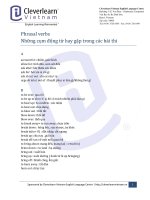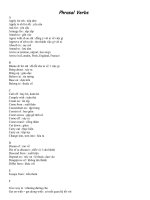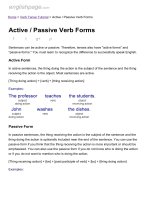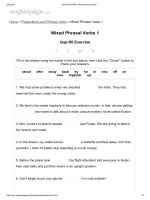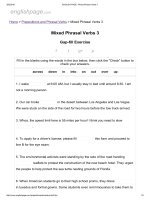ENGLISH PAGE phrasal verb dictionary
Bạn đang xem bản rút gọn của tài liệu. Xem và tải ngay bản đầy đủ của tài liệu tại đây (115.55 KB, 2 trang )
englishpage.com
Home > Prepositions > Phrasal Verb Dictionary
Phrasal Verb Dictionary
f
t
g+
p
To look up a phrasal verb, click a letter in the menu. The formats below are used in phrasal
verb definitions.
separable verbs: (talk * into)
inseparable verbs: (run into +)
object can be in both positions: (look * up +)
What are phrasal verbs?
1. A phrasal verb is a verb plus a preposition or adverb which creates a meaning different
from the original verb.
Example:
I ran into my teacher at the movies last night. run + into = meet
He ran away when he was 15. run + away = leave home
2. Some phrasal verbs are intransitive. An intransitive verb cannot be followed by an object.
Example:
He suddenly showed up. "show up" cannot take an object
3. Some phrasal verbs are transitive. A transitive verb can be followed by an object.
Example:
I made up the story. "story" is the object of "make up"
4. Some transitive phrasal verbs are separable. The object is placed between the verb and
the preposition. In this Phrasal Verb Dictionary, separable phrasal verbs are marked by
placing a * between the verb and the preposition / adverb.
Example:
I talked my mother into letting me borrow the car.
She looked the phone number up.
/>
1/2
5. Some transitive phrasal verbs are inseparable. The object is placed after the preposition.
In this Phrasal Verb Dictionary, inseparable phrasal verbs are marked by placing a + after
the preposition / adverb.
Example:
I ran into an old friend yesterday.
They are looking into the problem.
6. Some transitive phrasal verbs can take an object in both places. In this Phrasal Verb
Dictionary, such phrasal verbs are marked with both * and + .
Example:
I looked the number up in the phone book.
I looked up the number in the phone book.
7. WARNING! Although many phrasal verbs can take an object in both places, you must put
the object between the verb and the preposition if the object is a pronoun.
Example:
I looked the number up in the phone book.
I looked up the number in the phone book.
I looked it up in the phone book. correct
I looked up it in the phone book. incorrect
Also try our Verb + Preposition Dictionary to look up standard verb + prepostion
combinations.
Copyright © 2016 Englishpage.com, All Rights Reserved.
Contact us | Privacy Policy | Advertise with us
Your personal online English school. Learn English at Englishpage.com!
Weekly Lesson Grammar Book Vocabulary Verb Tenses Conditionals Modals
Gerunds / Infinitives Articles Prepositions Minitutorials Irregular Verbs Reading Room
Listening Lounge Games English Forums English Schools English · Foreign Dictionaries
English ·English Dictionaries Irregular Verb Dictionary Phrasal Verb Dictionary
Verb + Preposition Dictionary
/>
2/2

